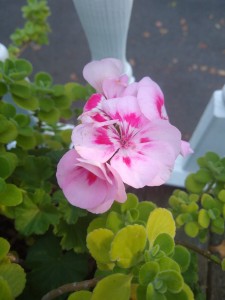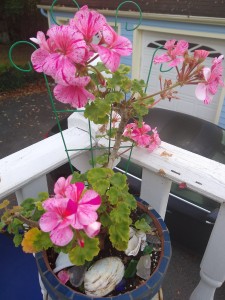 As I bring some of the geraniums inside, and consign others to death at the hands of the Frost God, I have to stop and consider the miraculous nature of these ubiquitous plants.
As I bring some of the geraniums inside, and consign others to death at the hands of the Frost God, I have to stop and consider the miraculous nature of these ubiquitous plants.
The bright, fluffy-headed, tender perennials that we call “geraniums” are actually members of the Pelargonium species. When we fill our window boxes and containers with modern hybrid geraniums, we are nurturing the descendants of two flowering species that hail from South Africa, a cradle of biodiversity and the homeland of many modern garden favorites. One of those plant parents is Pelargonium zonale, with pale pink or red flowers and leaves that are “zoned” or ornamented with colored rings that contrast with the predominant green color. The other parent is Pelargonium inquinans, with umbels, or rounded flowerheads in shades of rose to deep red. In 1844, the marriage of those two species resulted in the development of the first scarlet-flowered geranium–Pelargonium x hortorum. The “x” in the Latin names signifies the plants’ hybrid nature.
Various pelargonium species arrived from South Africa beginning in the 1600’s as traders and merchants began stopping at ports on the African continent’s southern tip. The great botanist John Tradescant reportedly grew one of those new pelargoniums in his London garden in the early to mid 1600’s. Pelargonium zonale arrived in Europe in 1710 and the inquinans species arrived four years later in 1714. A host of other new pelargonium and other species arrived later in the 1700’s, when King George III sent Scottish botanist Francis Masson to South Africa with orders to collect as many new plants as possible.
Even before King George’s reign, colonists or traders brought pelargoniums to the United States, where they first appeared in 1732.
The successful movement of pelargoniums from South Africa to Europe was miraculous in and of itself, since the seeds or cuttings had to be transported thousands of miles by ship. The perils of salt water, insecure storage and shipwrecks were a constant threat. The plants that we use so casually today have hardiness in their DNA.
The far-flung plant hunting of the sixteenth, seventeenth and eighteenth centuries provided the raw material for the geranium crazes at the beginning and end of the nineteenth. The mysteries of pollination revealed themselves in the Victorian era and hybridization of plants took off. According to Susan Conder’s wonderful book, The Complete Geranium, the knowledge of pollination even filtered down to affluent young ladies who would “hang nosegays of especially lovely geraniums upside down over their own plants, hoping to achieve cross pollination.” While the young ladies were busy with their nosegays, plant breeders were even busier trying to conjure up new varieties. At various times, nineteenth century catalogs listed over 800 varieties. Needless to say, many of those Pelargoinum x hortorum varieties were virtually indistinguishable from each other.
 The common geranium has gone in and out of fashion since its arrival on the horticultural scene. It returned to vogue after the Second World War and took off after Penn State professor Richard Craig bred ‘Nittany Lion Red’, a seed-raised pelargonium that was a forbearer of the modern bedding geranium.
The common geranium has gone in and out of fashion since its arrival on the horticultural scene. It returned to vogue after the Second World War and took off after Penn State professor Richard Craig bred ‘Nittany Lion Red’, a seed-raised pelargonium that was a forbearer of the modern bedding geranium.
These days, of course, we can obtain Pelargonium x hortorum just about everywhere, along with some of its relatives, like the regal or ‘Martha Washington’ geraniums, not to mention ivy-leafed, scented-leafed and fancy-leafed varieties.
My father loved bright red geraniums best and used them to fill front porch containers and decorate his father’s grave. When I was younger I rebelled against annual plants, including geraniums, and reveled in the sterling qualities of perennials. The miraculous nature of the common geranium eluded me.
But Nature has a way of getting back at horticultural snobs. When my daughter was old enough to start accompanying me on garden center visits, she fell in love with geraniums and begged me to buy them. I gave in and common geraniums have been growing on me and in my garden ever since. Snobbery gave way to appreciation, which ultimately led to understanding of the disparate forces that came together over the course of many centuries to give me plants like the white geraniums currently blooming in front of my house.
If happiness is being able to see the miraculous in everyday things, I certainly owe some of mine to the common geranium.
